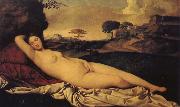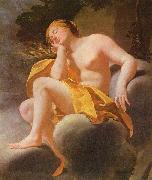Wholesale Oil Painting No Minimum |
|||||||||||
|
|
|||||||||||

|
|||||||||||
|
|
|
||||||||
GiorgioneItalian 1476-1510 Giorgione Galleries For his home town of Castelfranco, Giorgione painted the Castelfranco Madonna, an altarpiece in sacra conversazione form ?? Madonna enthroned, with saints on either side forming an equilateral triangle. This gave the landscape background an importance which marks an innovation in Venetian art, and was quickly followed by his master Giovanni Bellini and others.Giorgione began to use the very refined chiaroscuro called sfumato ?? the delicate use of shades of color to depict light and perspective ?? around the same time as Leonardo. Whether Vasari is correct in saying he learnt it from Leonardo's works is unclear ?? he is always keen to ascribe all advances to Florentine sources. Leonardo's delicate color modulations result from the tiny disconnected spots of paint that he probably derived from manuscript illumination techniques and first brought into oil painting. These gave Giorgione's works the magical glow of light for which they are celebrated. Most entirely central and typical of all Giorgione's extant works is the Sleeping Venus now in Dresden, first recognized by Morelli, and now universally accepted, as being the same as the picture seen by Michiel and later by Ridolfi (his 17th century biographer) in the Casa Marcello at Venice. An exquisitely pure and severe rhythm of line and contour chastens the sensuous richness of the presentment: the sweep of white drapery on which the goddess lies, and of glowing landscape that fills the space behind her, most harmoniously frame her divinity. The use of an external landscape to frame a nude is innovative; but in addition, to add to her mystery, she is shrouded in sleep, spirited away from accessibility to her conscious expression. It is recorded by Michiel that Giorgione left this piece unfinished and that the landscape, with a Cupid which subsequent restoration has removed, were completed after his death by Titian. The picture is the prototype of Titian's own Venus of Urbino and of many more by other painters of the school; but none of them attained the fame of the first exemplar. The same concept of idealized beauty is evoked in a virginally pensive Judith from the Hermitage Museum, a large painting which exhibits Giorgione's special qualities of color richness and landscape romance, while demonstrating that life and death are each other's companions rather than foes. Apart from the altarpiece and the frescoes, all Giorgione's surviving works are small paintings designed for the wealthy Venetian collector to keep in his home; most are under two foot (60 cm) in either dimension. This market had been emerging over the last half of the fifteenth century in Italy, and was much better established in the Netherlands, but Giorgione was the first major Italian painter to concentrate his work on it to such an extent ?? indeed soon after his death the size of such paintings began to increase with the prosperity and palaces of the patrons. |
||||||||
|
|
||||||||
Sleeping Venus
Sleeping Venus Painting ID:: 44901 |
mk176
c.1510
Oil on canvs
108.5x175.2cm
mk176 c.1510 Oil on canvs 108.5x175.2cm |
|||||||
|
|
||||||||
Simon Vouetb. 1590, Paris, d. 1649, Paris.French painter and draughtsman. Although at the time regarded as one of the leading French painters of the first half of the 17th century, he is now known more for his influence on French painting than for his actual oeuvre. He made his reputation in Italy, where he executed numerous portraits for aristocratic patrons and was commissioned for religious subjects. Although the early Italian works show the influence of Caravaggio, his work was subsequently modified by the Baroque style of such painters as Lanfranco and the influence of the Venetian use of light and colour. |
||||||||
|
|
||||||||
|
|
Sleeping Venus
Sleeping Venus Painting ID:: 61491 |
1630/40 100,5 X 84 cm. Museum of Fine Arts, Budapest 1630/40 100,5 X 84 cm. Museum of Fine Arts, Budapest |
||||||
|
|
||||||||
Artemisia GentileschiItalian 1593-1652 Artemisia Gentileschi Gallery Gentileschi was born on July 8, 1593 in Rome. She was the daughter of the painter Orazio Gentileschi and was trained by him. Our perception of Gentileschi has been colored by the legend surrounding her. Her alleged rape by her father colleague, the quadratura painter Agostino Tassi, when she was 17, was the subject of a protracted legal action brought by Orazio in 1611. Although she was subsequently married off to Pietro Antonio di Vicenzo Stiattesi in 1612 and gave birth to at least one daughter, she soon separated from her husband and led a strikingly independent life for a woman of her time - even if there is no firm evidence for the reputation she enjoyed in the 18th century as a sexual libertine. After her marriage, Gentileschi lived in Florence until about 1620. She then worked in Genoa and settled in Naples in 1630. Gentileschi traveled to England in 1638-40, where she collaborated with her father on a series of canvasses for the Queen House, Greenwich (now Marlborough House, London). Gentileschi died in Naples in 1652. It is tempting to adduce the established biographical data in partial explanation of the context of her art: the sympathy and vigor with which she evokes her heroines and their predicaments, and her obsession with that tale of female triumph, Judith and Holofernes. But such possibilities should not distract attention from the high professional standards that Gentileschi brought to her art. In a letter, dated July 3, 1612, to the Grand Duchess of Tuscany, Orazio claimed that "Artemisia, having turned herself to the profession of painting, has in three years so reached the point that I can venture to say that today she has no peer. Despite the obvious exaggeration, one can agree that Gentileschi art was of a consistently high quality virtually from the beginning. |
||||||||
|
|
||||||||
|
|
Sleeping Venus
Sleeping Venus Painting ID:: 78372 |
Oil on canvas, 37 x 56.75 in
Date 1625-30
cyf Oil on canvas, 37 x 56.75 in Date 1625-30 cyf |
||||||
|
|
||||||||
|
Artemisia Gentileschi Italian 1593-1652 Artemisia Gentileschi Gallery Gentileschi was born on July 8, 1593 in Rome. She was the daughter of the painter Orazio Gentileschi and was trained by him. Our perception of Gentileschi has been colored by the legend surrounding her. Her alleged rape by her father colleague, the quadratura painter Agostino Tassi, when she was 17, was the subject of a protracted legal action brought by Orazio in 1611. Although she was subsequently married off to Pietro Antonio di Vicenzo Stiattesi in 1612 and gave birth to at least one daughter, she soon separated from her husband and led a strikingly independent life for a woman of her time - even if there is no firm evidence for the reputation she enjoyed in the 18th century as a sexual libertine. After her marriage, Gentileschi lived in Florence until about 1620. She then worked in Genoa and settled in Naples in 1630. Gentileschi traveled to England in 1638-40, where she collaborated with her father on a series of canvasses for the Queen House, Greenwich (now Marlborough House, London). Gentileschi died in Naples in 1652. It is tempting to adduce the established biographical data in partial explanation of the context of her art: the sympathy and vigor with which she evokes her heroines and their predicaments, and her obsession with that tale of female triumph, Judith and Holofernes. But such possibilities should not distract attention from the high professional standards that Gentileschi brought to her art. In a letter, dated July 3, 1612, to the Grand Duchess of Tuscany, Orazio claimed that "Artemisia, having turned herself to the profession of painting, has in three years so reached the point that I can venture to say that today she has no peer. Despite the obvious exaggeration, one can agree that Gentileschi art was of a consistently high quality virtually from the beginning. Sleeping Venus Oil on canvas, 37 x 56.75 in Date 1625-30 cyf |
||||||||
|
|
||||||||
|
Prev Next
|
||||||||
|
|
||||||||
|
Related Paintings to Artemisia Gentileschi :. |
||||||||
|
|
||||||||
|
CONTACT US |



